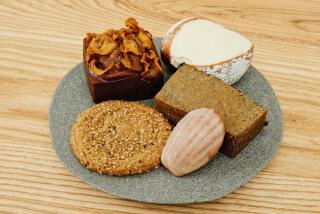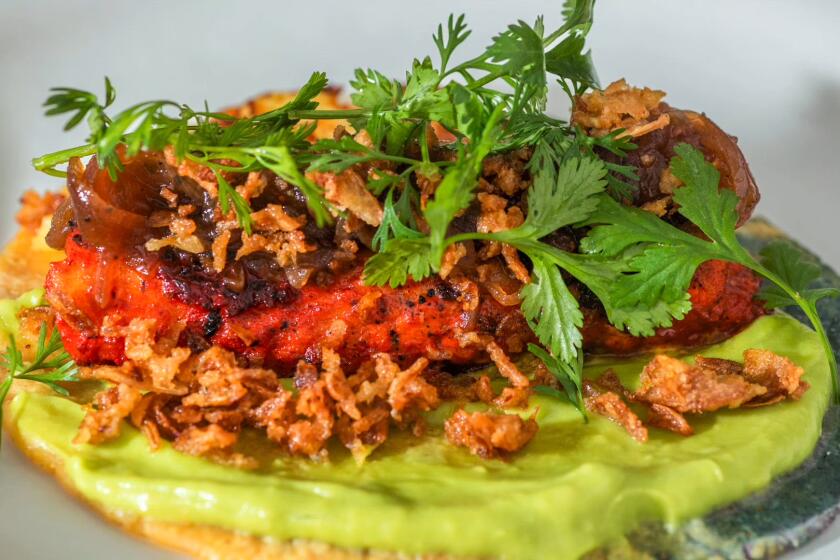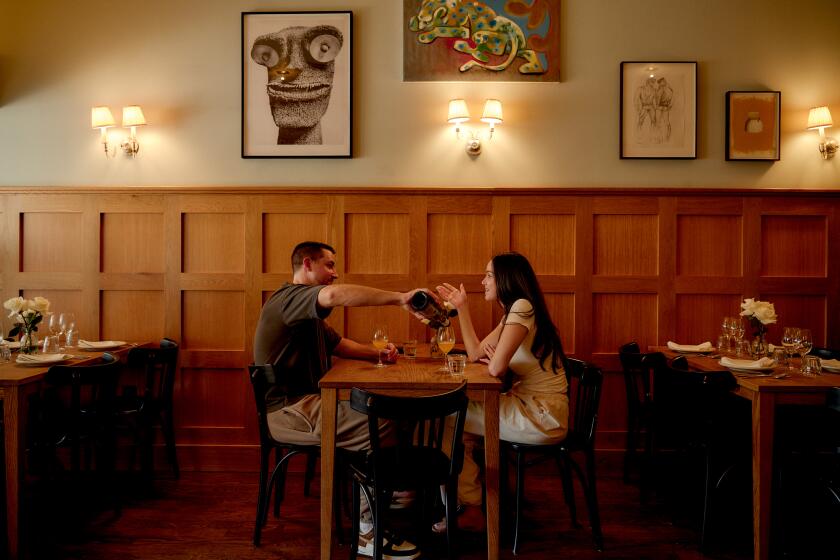The Capital of Koreatown
The splashy new Koreatown Galleria stands like a beacon signaling the entry to the heart of the Korean community in Los Angeles.
This $33-million shopping plaza at Olympic Boulevard and Western Avenue gives perspective to what has been, for the most part, an undefined collection of mom-and-pop businesses along Olympic from Crenshaw Boulevard east to the 110 Freeway. The Galleria captures it all--shops, a market, bakeries and restaurants.
Glossy, stylish and stimulating, it’s the kind of invitation to Koreatown that could well make this area so rich in cuisine the kind of destination neighborhood it always should have been. The basement houses a cookware store and bulk-food warehouse. The ground floor contains a vast supermarket and two excellent bakeries. Fine china and crystal are on the second floor. And the third lures hungry shoppers with a coffeehouse and a food gallery that includes 11 restaurants.
The range of food is astonishing. In addition to barbecued meats, dumplings and other Korean dishes, there are sushi and sashimi, pastries and exquisite European-style cakes--even hot dogs and French fries. Vietnamese pho, Japanese udon, Korean-style Chinese food, espresso and cappuccino, they’re all here too.
The Galleria is a grand space, filled with light on the upper levels from a soaring atrium roof. Shops on the second floor are arranged around a courtyard where a fountain splashes and palm trees grow in marble-walled beds. The food gallery above offers seating inside or on an open-air patio surrounded by a garden.
Allen H. Park, the managing director, chose food purveyors on the basis of experience and reputation. For example, Kang Seo Myun Oak, a restaurant in the food gallery, originated in Seoul and has another branch in Koreatown. It specializes in the cold noodle soup naengmyon, a favorite in hot weather. The owners of Jin Heung Ghak, a Chinese restaurant, serve the same food at the Mandarin House on West 8th Street. Mannaria restaurant borrows recipes from Dong Il Jang, an 8th Street institution.
The Galleria, financed by a partnership of seven Korean Americans, opened in October. The structure expresses community and national pride. Visitors entering from Olympic Boulevard see a free-form image of the rose of Sharon hibiscus in the marble floor. This is the Galleria’s logo, and South Korea’s national flower.
Hours are long, 7 a.m. to midnight daily. The market is open those hours; other shops open later, and the restaurants start up around 10 a.m. By lunchtime, customers are lined up for bibim bap, kimchi fried rice, hand-pulled noodles, spicy seafood stews, chicken teriyaki, broiled fish, boba drinks, shaved ice concoctions and much more.
“Seventy [percent] to 80% of our customers are Korean, but I am starting to see more of the non-Korean community, more of a balance,” says Jinah Kim of the Tofu House. The supermarket especially attracts a diverse crowd because it offers a wide assortment of fresh produce at reasonable prices.
Park says Westsiders spot the Galleria on the way to Staples Center, then come back. One such visitor was eager to try kimchi pizza, advertised on a menu board along with kimchi paella, kimchi falafel and other startling concoctions.
The only problem is, there are no such dishes. The menu, hung high in the food gallery, is merely artwork. But when you think about it, kimchi pizza might not be such a bad idea.
Third Floor: Restaurants
Start a Galleria tour on the top level, with a visit to the Food Gallery.
Begin on the east side with Jin Heung Ghak Mandarin Cuisine, where you can eat inside, rather than carrying a tray to the broad expanse of tables where most people sit. Here, the food is Chinese with a Korean twist. The most popular dishes are chow mein and chachiang mein, which is no surprise. The noodles (mein) are handmade, silky and fresh.
The noodles for chachiang mein are topped with meat or seafood (shrimp, squid and sea cucumber) in a black bean sauce. You won’t find anything quite like it in Chinatown, insist the owners, Hsien Chien Ho, who is Chinese born in Korea, and his Korean wife, Joanna. Packets of their salty, slightly sweet black bean sauce are on sale in the Galleria Market in the hot foods case. Take one home to heat and serve over noodles or rice.
Bopioca, a drink and dessert stall, is attached to Jin Heung Ghak. Stop here for early-morning coffee, or order a smoothie, boba drink or shaved ice dessert. Bopioca’s toppings for shaved ice, a dessert popular from Indonesia to Taiwan, include taro, sweet potato, rice balls, lotus seeds, lychees, pineapple and red beans.
Tofu lovers will relish the wide assortment of dishes at the Tofu House. The big seller is a soupy dish of soft tofu, beef broth and meat or seafood known as soon tofu. Red bean paste stew combines bland tofu pieces with intensely spicy red broth. In sharp contrast to these spicy dishes is a cold soup of noodles in a delicate “broth” of freshly ground soybeans, peanuts and sesame seeds.
You might see college students or Korean women on a shopping spree snacking on rice cakes in hot red pepper paste, one of the items you’ll find at Cham Cham Cham. There’s a picture menu, but no information in English, so you’ll have to ask what the dishes are. Choices include rice noodles with hot pepper sauce, cabbage, cucumber and bean sprouts and cold radish broth with noodles, tomatoes, chiles and green onions.
The specialty at Kang Seo Myun Oak is naengmyon, a big bowl of cold, slightly sweet broth that contains skinny buckwheat noodles, hard-cooked egg, a translucent slice of Asian pear and a few slices of beef, daikon and cucumber. Tiny cups of rice vinegar and hot mustard are just enough seasoning. The taste is light and addictive, unlike any noodle soup you may have had.
Yang Ji Express is known for bibim bap--rice tossed with more than 20 toppings of your choosing. Or let the attendant mix in a little of everything. Broth and a plate of kimchi come with the rice, so you get plenty to eat.
In a corner next to Yang Ji, Jin Su Sung Chan serves the one Korean dish that everyone knows: barbecued meat. In addition to short ribs, beef and spicy seasoned pork, the cooks barbecue chicken and shrimp. If you want to branch out, try spicy black cod, short ribs soup, a seafood pancake or spicy octopus. The name of the stall is not in English, but the photo menu provides translations.
At Kal Gook Soo, there is chicken ginseng soup, a fascinating dish that includes chestnuts and jujubes (wrinkly red dates, not the candy), as well as handmade noodles in soup, dumplings, Korean sushi and soft rice with abalone. Look at the photos on the wall, then decide what to eat.
Sue Lee, who runs Mannaria, is the sister of Sung Kim, the owner of Dong Il Jang, one of the oldest restaurants in Koreatown. She uses some of her brother’s recipes, so you’ll find kimichi fried rice here as well as chicken and beef teriyaki, spicy rice cakes, cold soba and, for those with really exotic tastes, hamburger steak.
What is a Vietnamese restaurant doing in Koreatown?
“Right now, pho is very popular in Korea,” says Justin Yoo, whose Miss Pho Saigon specializes in the Vietnamese noodle soup. His most complex version is pho Saigon, which contains brisket, flank and rare steak, fish cake, beef and fish balls, squid, shrimp, book tripe, tendon, onions, jalapenos, bean sprouts, basil, cilantro and a lime wedge.
Opposite the food gallery is the Sejong Book Store, which deals in Korean-language books, but has a few cookbooks in English. A good choice for western cooks is “A Korean Mother’s Cooking Notes” by Chang Sun-Young. It’s addressed to young Korean women (specifically, her sons’ wives), learning to cook traditional food in the United States. The publisher is Ewha Woman’s University in Seoul.
From the bookshop, walk into Cafe Galleria, which has a long menu of coffees, teas, fancy drinks, juices and other treats. Don’t expect coffee in an ordinary mug. The cafe has a stunning collection of cups in colorful patterns. If you approach from the Galleria rather than the bookstore, you will see the almost-real array of French crepes arranged like a menu in the window. Most are sweet, topped with fruits and sweet whipped cream or ice cream. They have names like Alsace, Bordeaux, Bretagne, Versailles and Nice. One topped with kiwifruit is a digestif.
Second Floor: Tableware
This is mostly the domain of clothing and cosmetics. But there is one store for the cook: the Silver Spoon Collection, a shop that displays Waterford crystal and dinnerware from Wedgwood, Limoges, Villeroy & Boch, Royal Copenhagen and other prestige companies. Interestingly, there’s nothing from South Korea.
First Floor: The Market
Many people come to the Galleria just to shop in the supermarket. This vast Galleria Market has everything needed for Korean cooking as well as general merchandise, prepared foods and Korean-style packaged convenience foods. A large section is devoted to panchan, the side dishes served with Korean meals in restaurants. A hot-foods case is filled with dishes ready for dinner, including soups, cooked vegetables, fish and Korean sausages, even rice--either plain steamed white rice or brown rice with beans. On the other side is a case of sushi, followed by shelves of kimchi.
The produce section is stocked with Korean greens such as ssukkat, sesame and minari leaves, bags of soy sprouts, twist chiles and fat Korean zucchini. Seasonal fruit is stocked in abundance and sometimes cut for sampling.
The meat department offers marinated meats for barbecuing and many brands of Korean barbecue sauce. Look also for bulky packages of fish or crab soup mix that contain fish, seafood, noodles and vegetables, ready to dump into a pot of boiling water. Trays of sashimi decorative enough to take to a party are also in this area.
Inside the Galleria Market are a couple of interesting food shops.
Near the checkout stands is Long Life Foods Tofu, which sells prepared dishes with tofu, including a silky tofu salad that has converted at least one tofu-hater into a fan. This shop produces its own tofu, which you can buy in packages to use at home. The other shop, Koko’s Chicken, makes hot dogs and fries, and two traditional Korean snacks: fish-shaped cakes stuffed with red beans (watch as they are baked in heavy black molds in the window), and pancakes filled with melted sugar that are so irresistible, you won’t be able to stop at one.
Near the market you’ll find Wien Konditorei und Cafe, which sells European-style cakes, cookies, sweet rolls and breads, some with a Korean touch such as almond-sprinkled loaves filled with diced chestnuts. Milk baguettes are sliced and coated with butter and sugar, ready for snacking.
Wien’s cakes are glorious, and you can buy them by the slice or whole. The eye-catching cakes coated with large, swirled tufts of white frosting are white or chocolate chiffon. Golden ribbons are tied around cheesecakes. Strawberries dusted with sugar and little mounds of meringue finish off a cream cake.
Small treats include little oval plastic containers that hold a saucy rendition of tiramisu. Wien makes crisp, golden almond tuiles that go well with coffee, which the shop also sells. Conveniently, there’s a line of tables and chairs just outside.
The grandmotherly woman whose image is the logo for Ho Won Dang is Jah Ho Cho, who founded the rice cake shop in Seoul in 1953. A son, Un-hee Chung, owns this shop, which produces rice cakes and cookies for ceremonies and celebrations. Tiny yellow cookies to go with tea are naturally colored with pine tree pollen. Crushed pine nuts coat crisp, fried cookies. Small round rice cakes are filled with fresh grapes, chestnuts, grapefruit segments or cherries. Deep-fried, syrup-soaked cookies contain a tiny, tantalizing shred of citrus peel.
Buy an assortment and the shop will pack them in a gift box, wrapped in a large square of peach fabric tied in a fluffy bow.
In a refrigerated case, Ho Won Dang displays jars of omijah concentrate to dilute for a sweet tart pink drink. Omijah is a rare red fruit that grows in high, cold parts of Korea. Chung’s farm produces most of the Korean crop.
Of all the shops in the Galleria, this one is the most traditional. Its woodsy look transports you to times long past in a faraway land.
Basement: Housewares
Stairs or an elevator will take you to the basement and KitchenPlus, Inc., a housewares shop that caters mainly to restaurants. However, home cooks will find plenty to buy, including South Korean-made plates and bowls, woks, skillets, bulgogi grills and sets of metal chopsticks and long-handled spoons. Notice the 50-bowl rice cookers, the bright-green $349 garlic slicer and the wooden trays for sashimi that are shaped like bridges.
On the way home, stop back to the market level for Galleria Flowers, where you can order a table centerpiece. In addition to fresh flowers, the shop displays containers of lucky bamboo and unusual artificial arrangements.
As you leave, you will pass Jungle Juice, a drive-up stand where you can order a coffee or juice drink for the road.
More to Read
Eat your way across L.A.
Get our weekly Tasting Notes newsletter for reviews, news and more.
You may occasionally receive promotional content from the Los Angeles Times.










